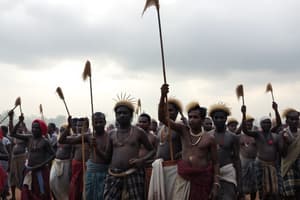Podcast
Questions and Answers
What problems did Birsa set out to resolve?
What problems did Birsa set out to resolve?
Birsa set out to resolve the issues of slavery to dikus, loss of livelihoods, and the threat to tribal religion.
Who were the outsiders referred to as dikus?
Who were the outsiders referred to as dikus?
The dikus were outsiders, often from non-tribal or British backgrounds, who encroached on tribal lands and livelihoods.
How did the lives of tribal people change under British rule?
How did the lives of tribal people change under British rule?
The lives of tribal people changed as their familiar ways of life disappeared, their livelihoods were threatened, and their religious practices faced challenges.
What is jhum cultivation?
What is jhum cultivation?
Tribal societies had sharp social divisions characteristic of caste societies.
Tribal societies had sharp social divisions characteristic of caste societies.
Birsa was born in a family of ______.
Birsa was born in a family of ______.
Flashcards are hidden until you start studying
Study Notes
Birsa's Movement
- Birsa was a man who claimed to be able to cure diseases and multiply grain
- Birsa declared that God had appointed him to save his people
- Birsa believed that dikus (outsiders) were enslaving his people
- Birsa’s followers included Mundas, Santhals, and Oraons
- Tribal people were concerned about changes to their way of life due to British rule
Tribal Societies
- Tribal societies had different customs and rituals than those practiced by Brahmans
- Tribal societies lacked the sharp social divisions seen in caste societies
- Despite a shared sense of kinship, economic and social differences existed within tribes
Tribal Livelihoods
- Shifting cultivation (jhum cultivation) was practiced on forest land
- Shifting cultivators cleared land by cutting trees and burning vegetation to fertilize the soil
- Shifting cultivators practiced broadcasting, where seeds are scattered rather than sown in plowed land
- Shifting cultivators used an axe for cutting trees and a hoe for preparing the soil
- Fields were left uncultivated for several years to allow soil recovery
- Shifting cultivators resided in hilly, heavily forested areas of northeastern and central India
- Tribal lives were dependent on free movement within forests
Studying That Suits You
Use AI to generate personalized quizzes and flashcards to suit your learning preferences.



